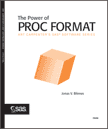NJSUG 2009 Fourth Quarter Meeting
The meeting was in the morning (9:00am - noon) on Friday, December 11th at:
SAS Bedminster Training Center
1430 US Highway 206 North
Suite 200
Bedminster, NJ 07921
Phone 908-470-0080
Agenda
09:00-09:20
09:20-10:20
10:20-10:40
10:40-11:40
11:40-noon
Registration, gathering and continental breakfast
Let Your Data Power Your DATA Step (Howard Schreier)
Break
Using PROC RANK and PROC UNIVARIATE to Rank or Decile Variables (Jonas Bilenas)
Random Access, Door Prizes and Closing Remarks
Let Your Data Power Your DATA Step: Making Effective Use of the SET, MERGE, UPDATE, and MODIFY Statements
Downloads
Download paper(pdf, zipped) and view the on-line presentation. Or visit Howards' web site at http://www.howles.com.
Abstract
The "plain vanilla" SET statement is ubiquitous in SAS(r) programming. It feeds the contents of a data set to a DATA step. This usage only scratches the surface of the capabilities of the SET statement and its siblings (MERGE, UPDATE, and MODIFY). Data sets typically are more than collections of individual values; they also incorporate information in the form of structure and organization. The SET, MERGE, UPDATE, and MODIFY statements are versatile tools that can use such information to combine and refine data. This tutorial will explain and illustrate the basic capabilities of each of these statements and will compare their advantages and disadvantages in different programming situations.
Author

Howard Schreier
is an independent consultant based in Arlington,
Virginia. He has used SAS software since 1981 and has presented papers
at numerous NESUG, SESUG, and SUGI conferences. Since 1989, he has made
nearly 8,000 postings to SAS-L, and in 2004 he entered the SAS-L Hall of
Fame.
Using PROC RANK and PROC UNIVARIATE to Rank or Decile Variables
Downloads
Download paper(pdf, zipped) or visit Jonas' web site at http://www.jonasbilenas.com/sas_stuff.html.
Abstract
In direct marketing applications prospects are often ranked by scores that predict response, risk and/or profitability. Justification is to evaluate lifts in performance by soliciting the most profitable individuals as defined by score ranking. Many programmers write complicated code using PROC SORT, MACRO calls, and DATA STEPS to rank or decile these scores. These programs often don't handle score ties which can result when 2 or more prospects with the same score end up in 2 or more ranks. We will show how using PROC RANK will provide a quick and simple way to rank or decile individuals that will handle ties with the PROC RANK TIES option. We will look at the syntax of PROC RANK with a number of examples and applications. Since PROC RANK does not have a WEIGHT statement to handle weighted samples we will show how to handle weights using PROC UNIVARIATE and PROC FORMAT to perform a weighted ranking.
Author

Jonas Bilenas is VP of Decision Science at JP Morgan Chase Bank in the area of Consumer Acquisitions and Targeting. Jonas has been using SAS since 1986 in areas of credit modeling, reporting, experimental design, simulation and optimization. He is the author of the SAS Press Book, "The Power of PROC FORMAT", and is currently working on a new book with the tentative title of "SAS Applications in the Credit Industry".
Annual SAS Book Sale
This is the NJSUG Annual SAS Book Sale meeting. All attendees will get
a 20% discount certificate for SAS publishing books. Visit SAS Publishing
bookstore and see wonderful
new books and old favorites.